This is a no-nonsense, straightforward guide to working safely with pastels.
Looking around the Internet, one could get the idea that soft pastels are a dangerous artist’s medium. Unfortunately, there’s a lot of conflicting information available. I cut through the confusion, draw on safety info from several pastel manufacturers, and offer an inexpensive, highly effective solution for dealing with airborne pastel dust.
The truth is that, with a little attention, working safely with soft (chalk) pastels is not hard to do.
TL;DR: The most actionable, important info starts here.
Note: I am unaffiliated with the brands I list below. I do not make any money by mentioning them.
Article Outline
- What are Soft Pastels Made Of?
- Are Pastel Pigments Safe?
- Are Pastel Binders Safe?
- Are Pastel Fixatives Safe?
- Safety Standards and Warnings
- Art Supply Sources: Authenticity, Quality, Price
- The Artist’s Best Practices for Working Safely with Pastels
- Minimizing and Avoiding Pastel Dust
- More Tips for Working Safely with Pastels
- The Corsi-Rosenthal Box
- Footnotes
[If anyone knows how I can remove the weird spacing in my outline above, please message me, thanks!]
What are Soft Pastels Made Of?
Chalk pastels are a dry medium. These pastels are made from pigment, plus enough binder to form a stick. This means they are one of the most pure, stable, and color-rich media in existence. They do not yellow as oil paint can, nor darken like acrylics. What you see is what you get.*
The term “soft pastels” actually refers to any chalk pastel stick, ranging from harder to softer. Harder pastel sticks are usually square in profile, and hold together quite firmly. Conversely, softer pastels are round, and may crumble if handled aggressively, or when applied with too much pressure.
A pastel’s relative hardness or softness depends on the pigment and the components of the binder. Certain pigments and binders are derived from harder minerals.
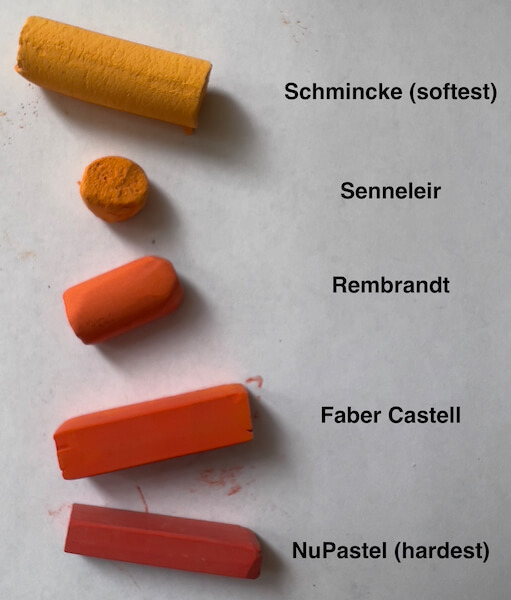
(Oops, I misspelled Sennelier, i before e.)
So the first consideration is …
Are Pastel Pigments Safe?
I first studied art in college, in the later 1980s. Back then, pastels probably weren’t as safe as they are today. Accordingly, our teachers taught us that some colors contained toxic pigments.
Fortunately, manufacturing knowledge, and safety considerations, have advanced since my college days. Some toxic components have been replaced with safer alternatives. Nevertheless, many art supply manufacturers still use a few controlled components in very select colors, like cadmium in red. Albeit, the level of the toxic component is so low, they pose no additional risk over the non-toxic ingredients.
To state that differently: Yes, some so-called toxic ingredients may be present, but at such minute levels that they are as safe as the other ingredients found in the artist’s color.
For example, Winsor & Newton says this about cadmium:
The level of soluble cadmium in the pigments is so low that no hazard warnings are needed, and they pose no greater risk after swallowing or breathing in than other pigment types.
— Winsor & Newton
Are Pastel Binders Safe?
The answer must be yes, or all pastels would be required to come with safety warnings. The “Safety Standards and Warnings” section below applies to all ingredients found in chalk pastels, pigments and binders alike. Further, it’s informative to know what the companies themselves say, about working safely with their pastels and other products.
By the way, did you know you can save pastel dust and broken bits, and re-form sticks with it?
Are Pastel Fixatives Safe?
This depends on the fixative brand and how it’s used, of course. Check the label of your fixative for more information. Most fixatives contain an (acrylic) resin mixed with a solvent, and should be sprayed outdoors.
The only natural fixative I’m aware of—and I certainly don’t know them all—is SpectraFix Degas Spray Fixative. As the name implies, it’s based on the formulation believed to have been used by Edgar Degas. Not only does it appear to treat colors with respect, leaving them unaltered, but it’s made with 100% natural, non-toxic materials, is odorless, and is safe to use indoors.
DIY Fixative Recipe
Naturally, since Degas made his own fixative, you can too! This recipe—which uses the same ingredients as the Degas Spray Fixative above—comes from David Blaine Clemmons (sources here and here), who in turn got it from the Reed Kay book “The Painter’s Guide to Studio Methods and Materials.”
Mix:
- 1 part by volume powdered casein (comes from milk) with
- 2 parts by volume grain alcohol (like ethanol or 190 proof Everclear) and
- 5 parts by volume distilled water.
To apply his fixative, Clemmons uses a Preval Sprayer with the inner tube’s end filter removed, since it can apparently get clogged. You can also go the simpler route of application, and use a spray bottle or mouth atomizer to apply it in fine layers. (Larger droplets will apparently disappear when dry.)
Reportedly, 2 to 4 coats of this fixative should be enough, but if you apply it very finely, you may need more. Store unused fixative in the refrigerator, where it should last a few weeks.
(I’m eager to switch to this fixative using the mouth atomizer I’ve had forever … and just found in the first place I looked 😃. Taken altogether, this method is better for the planet than metal cans, acrylic resins, solvents and aerosol!)
Safety Standards and Warnings
When art supply manufacturers source material components, and produce their products, they must adhere to nationally and/or internationally agreed up on safety standards. Accordingly, any possible risks to your safety must be disclosed to you.
In the US, one such safety standard is regulated by OSHA, the Occupational Safety and Hazard Administration. In their brief on Hazard Communication Standard: Safety Data Sheets, they outline requirements for any “chemical manufacturer, distributor, or importer [to] provide Safety Data Sheets (SDSs) […] for each hazardous chemical, to downstream users, to communicate information on these hazards.” Most countries have similar requirements.
That means, if something in your art supplies contains a hazardous chemical, you as the “downstream user” must also be notified by an accompanying warning. These warnings are usually placed directly on the product’s label. Therefore, examine your pastel sticks, fixatives and other art supplies for such label warnings.
By being informed, you can take precautions, to ensure that you’re working safely with pastels.
If there is no warning on your modern, respectable brand art supplies, you can consider them safe. (Old, inherited, purchased-at-a-yard-sale art supplies, or from cheap sources such as dollar stores, might be a different story.)
Let’s take a look at what popular pastel manufacturers have to say about their products.
Sennelier
Art supply company Sennelier, who makes one of the most lauded brands of soft pastels, includes the following on their web site. (Emphases are mine, to demonstrate that warnings are provided, where warranted.)
Sennelier products may contain noxious ingredients, which would be indicated on the products in question. Furthermore, MAX SAUER reminds the user that particular care must be applied when handling products that are specified as dangerous on the labels, as required by regulation, that are placed on them. In the presence of such components, MAX SAUER reminds the user that it is always important to respect the following minimal precautions for use:
— Sennelier English Language Terms and Conditions, as of the date of this blog post
- Do not ingest the product;
- Avoid contact with skin and eyes;
- Wear appropriate attire and protect clothing, shoes and other clothing accessories;
- Keep the product away from a child who could use it alone and domestic animals, notably during use and storage;
- If applicable, supervision by an adult when the product is used by a child;
- The products must be stored away from light, in a ventilated and temperate environment (between 10 and 30°c).
Winsor & Newton
Similarly, you can find information at Winsor & Newton’s page, “How to understand health and safety information on our products.” Some toxic components are used in minute amounts. Currently, Winsor & Newton claims they offer Safety Data Sheets through their web site. (However, I couldn’t find any.) I did locate this page on “Safety in the studio: decoding hazard symbols.”
Faber-Castell
Faber-Castell is opaque about the safety of their products. Their excuse is, “Due to proprietary information, we are not able to publish our Safety Data Sheets on our website. We generally do not provide SDS information to the public.” A search of their web site provides little additional information. Frankly, I am not impressed.
Prismacolor (NuPastel)
I could find zero information about safety on the Prismacolor web site. The word “safety” is not mentioned anywhere. I find that baffling.
Royal Talens (Rembrandt Pastels)
On the other hand, I am encouraged by Royal Talens. They make Rembrandt pastels, as well as many other brands of art supplies. Fully transparent about the safety of their products, Royal Talens offers Safety Data Sheets (SDSs) on all relevant art supplies.
As of this date, Royal Talens lists no SDSs for pastel sticks, making it clear they contain nothing known to be toxic. The only relevant mention is for their pastel fixative. If you want to completely minimize any possible exposure to noxious components, to ensure you’re working safely with pastels, it appears that Rembrandt would be a very good choice.
Schmincke
This German maker of the softest pastel brand offers a detailed Health and Safety page on their web site. With regard to pastels, they state:
A well ventilated room represents a preventive measure here. When substantial quantities of dust are involved, a dust mask of filter class 2 is to be worn, while masks with filter type A2 and protective breathing equipment of filter class 2-P2 […] affords protection against solid and liquid particles in the air. A further means of protection involves the use of a suitable extraction hood equipped with filters for the substance concerned, that is, appropriate fine-pored absorption mats for dust […].
For this last point, building an extraction hood to collect pastel dust certainly sounds useful … but also very expensive. I think an alternative will do, therefore I recommend a Corsi-Rosenthal box, detailed below.
Art Supply Sources: Authenticity, Quality, Price
Getting the best price isn’t everything. Consider where you source your pastels and other art materials from. Purchase the best you can afford. When possible, buying straight from the manufacturer assures that you get an authentic and fresh product, produced according to the company’s latest standards.
I’ll say it right up front: I’m not a fan of Amazon. Buying from a second or third party, especially (but not exclusively) an unfamiliar company, may be cheaper, but also carries risk. Amazon is a “second party” at best (I’m guessing they usually buy from the manufacturer, to re-sell). Some of Amazon’s Marketplace sellers are “third parties” or worse (buying stock from re-sellers, to re-sell).
Some products from these companies may be lower cost, because they are from older or damaged stock. Furthermore, they could be “seconds,” containing a slight deviance from usual manufacturing standards. For example, pencils may already be broken inside, or be more prone to breaking during use, or have a sub-par wood casing that splinters during sharpening. Old supplies, or off-name brands, could contain less desirable ingredients. They may also be dryer, or have separated, or show color shifts between areas that were light-exposed, vs. under their labels (I’ve seen this happen with cheap pastel sticks). From one purchase to the next, off-brands may have inconsistent colors. Likewise, paper too degrades as it ages. (Have you ever bought a case of mega-sale computer printer paper that created a lot of dust, or jammed more frequently? It was arguably old and beyond its intended shelf-life.)
Best Sources
All that said, I’d be willing to place higher trust in the sourcing and product turn-around—i.e. freshness—of large, well-established art supply companies, like Jerry’s Artarama, Dick Blick and Utrecht in the US, and Boesner in Europe.
Still, sometimes going right to the source ends up being the cheapest option, or so close in price that it’s the smarter choice. Therefore, I recommend always checking the manufacturer’s web site for comparison.
The Artist’s Best Practices for Working Safely with Pastels
Now, let’s explore some common sense for the pastel artist.
There are three possible ways that a substance can penetrate the body:
- Ingestion (eating or drinking it)
- Skin absorption, or through a skin-breaking wound
- Inhalation (breathing it)
Avoiding Ingesting Pastels
There have long been rumors that Vincent van Gogh may have eaten his paints. There is no evidence that this is true, however. Further, when van Gogh experienced bouts of mental illness, to keep him safe, his doctors kept all liquid art materials out of his reach. That’s because it is, indeed, known that Vincent said he wanted to eat them.
I’ll tell you a not-so-secret secret: like van Gogh, I sometimes find myself wanting to eat my pastels. Why? They just look so good, so beautiful, so yummy! Pastel colors are apparently so stimulating to my high color sensitivity** that my mind wants them to be as tasty as they look. Nevertheless, I will never put one in my mouth!
Naturally, you shouldn’t either. But if you use pastels at the kitchen table, you might already be ingesting them. If you don’t wash your hands before you eat, you may be consuming pastels then, too.
Therefore, to avoid eating or drinking your art supplies, keep them separate from areas of food storage, preparation, and consumption. Similarly, keep them out of the reach of young children and pets.
Don’t make art where you sleep, either.
Also, if you paint in a home studio or room, and want to keep pastel dust out of the rest of your house, have studio-specific clothing. When you are done creating, change out of your studio clothing, preferably leaving them in the studio. Likewise, wash your hands thoroughly, especially before preparing or eating a meal.
Can Pastels be Absorbed Through the Skin?
The short answer is not really. The skin is an impermeable barrier to the components of virtually all pastel sticks. Unsurprisingly, holding pastels can dry the hands, as it wicks away oils and moisture from the skin. And, of course, the pigments can color the hands until you’ve washed. But they are unlikely to penetrate the skin all by themselves.
That said, an exception is if you have a deep enough cut or puncture wound. In that case, anything small enough can enter the body through such an opening, just like bacteria.
Still, let’s remember the first part of this post. If the pigments and binders are non-toxic, or toxic but present in vanishingly small amounts, they cannot poison the body. Even if you are holding a red cadmium-containing stick of pastels with your bare fingers, you’re still safe. Likely, the worst that can happen might be the irritation of a skin-breaking wound, if it is not kept clean and covered. Care for and protect any wounds.
When working with pastels, if you want to be ultra-careful, or prevent your hands from drying, use a barrier hand cream. Two brands are Gloves in a Bottle or Artguard Barrier Cream, but there are others. If you have a wound, use finger cots. Save them for special use, though, as they can create a lot of waste.
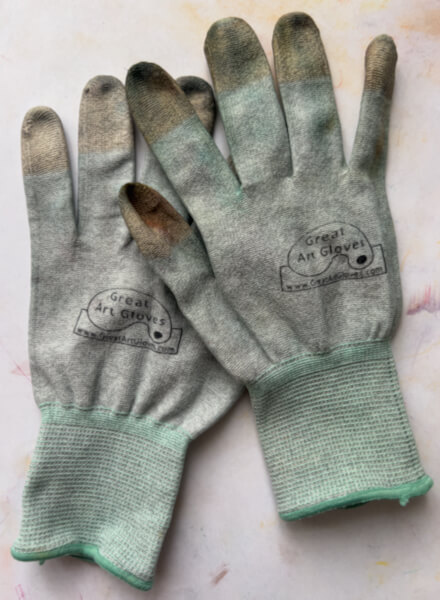
Another option is to purchase sets of washable pastel gloves (originally designed for working with electronics). The fingertips are dipped in foamed polyurethane, creating a pastel-impermeable barrier. My original source no longer offers the gloves shown above, but if you search for ESD fingertip coated, you should find quite inexpensive ones. The gloves can be washed at 40°C (105°F) with neutral detergent and reused many times.
Breathing Pastel Dust
This is the only concern that the pastel-using artist must carefully consider, in working safely with pastels. I have read one account of a very busy, long-hours pastel painter, breathing dust to a level that caused respiratory distress. (She recovered.)
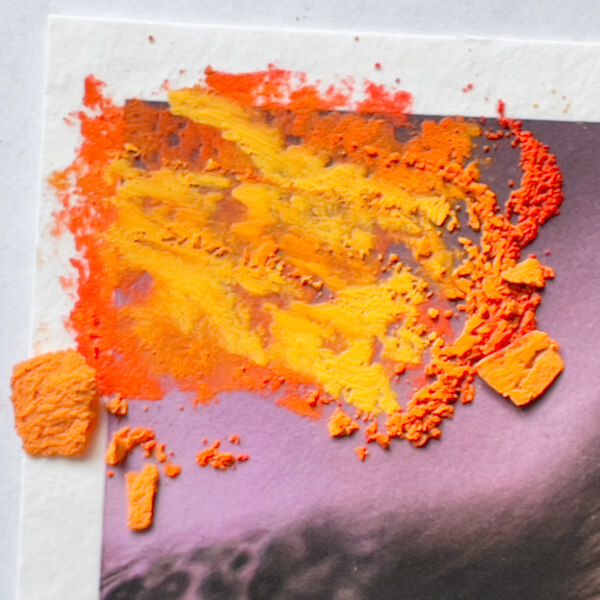
According to her article, breathed pastel dust can irritate the upper respiratory track. Once there, the dust mixes with mucous, is swallowed and eventually expelled from the body. Apparently, truly excessive exposure means dust can possibly enter the alveoli of the lower lungs, and remain there, though no proof is offered. (I’m not saying that’s false, I just don’t know.)
Therefore, being safe and protecting against inhaled pastel dust, is a good idea.
Minimizing and Avoiding Pastel Dust
- Don’t blow on your pastel paintings, ever. Doing so is the quickest way to make pastel dust airborne.
- Be gentle with your pastel application, to create less dust in the first place.
- Avoid using a stiff brush to “erase” unwanted pastel from a painting (doing so also makes the dust airborne). Instead, try erasing with these methods, in this order:
- use a small paintbrush to gently dab or sweep away the pastels,
- or a cotton swab next,
- or a knife or utility blade to gently scrape color away in the direction it was applied,
- or a kneaded eraser to dab color off (pinching off or kneading dust into the eraser as you go),
- or even a piece of soft, crustless bread.
- To remove excess pastel from a painting overall, take it outside (yes, outside!) and gently tap it on the back.
- Work on an easel, with the top of your painting slightly tipped towards you. This allows excess pastel dust to fall into the easel’s tray, rather than on the lower part of the painting.
If you’re susceptible to breathing dust, and you have respiratory concerns, I present two options:
- Consider wearing an appropriately rated dust mask or respirator. (Caution where respiratory illness or pregnancy is present; talk to your doctor.) If you choose this option, it’s important that you seek assistance with selecting and fit-testing the appropriate respiratory protection, so you’re truly protected.
- Build yourself an easy and inexpensive Corsi-Rosenthal box (below), to filter airborne dusts and other particulates in your studio.
More Tips for Working Safely with Pastels
- Keep a slightly damp cloth handy. Use it as needed, to wipe your hands, the easel’s tray, and other surfaces that may become dusty.
- Coat your hands with a barrier cream, like Gloves in a Bottle or Artguard Barrier Cream, or wear ESD fingertip coated gloves.
- Don’t touch your eyes or face while painting.
- Cover the floor around your easel and work area with a drop cloth or plastic barrier. The covering can be carefully removed and hosed off or laundered. (When laundering, use a second rinse.)
- Spray pastel fixative on your paintings outdoors, where breezes carry the aerosol away from you.
- Wear studio-only clothing and shoes, or a good smock that covers you. (I like Gustav Klimt’s, below.) When you are done, leave all garments in the studio, and close the door behind you.
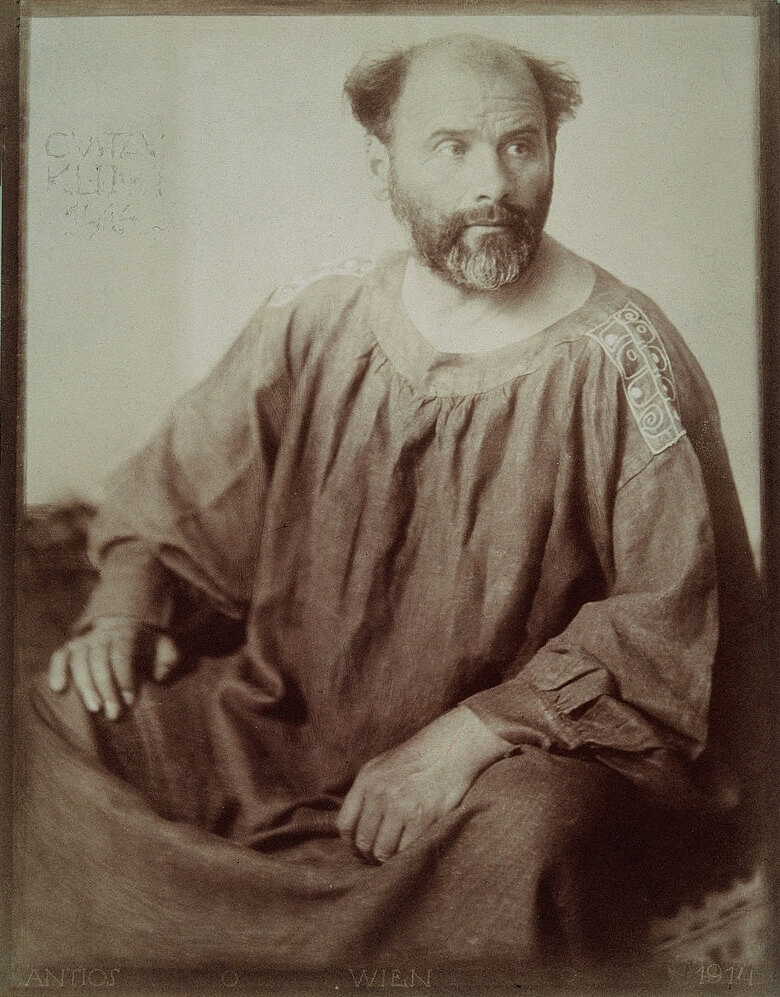
The Corsi-Rosenthal Box
This DIY (do it yourself) project is a straight-forward, inexpensive, and highly effective way to remove airborne dust from your studio space. The Corsi-Rosenthal Box was originally developed to provide indoor air filtration, to increase protection from COVID-19. Subsequently, with a different filter, it is used to filter air contaminated by wildfire smoke.
Rosenthal’s research has shown the following DIY design is the best to date. It outperforms a $1,000 high-end HEPA air cleaner (!!!), and all other DIY designs tested. Depending on use, the filters can last for up to 6-10 months before needing to be changed. (The appearance of dirt on the filters does not indicate they are no longer working.) For more information, see Rosenthal’s related articles.
How to Make a CR Box
This first illustration lists the materials needed, and shows how the CR Box is assembled. Simply tape everything together, sealing the edges and corners thoroughly. The specific type of filter listed is essential.
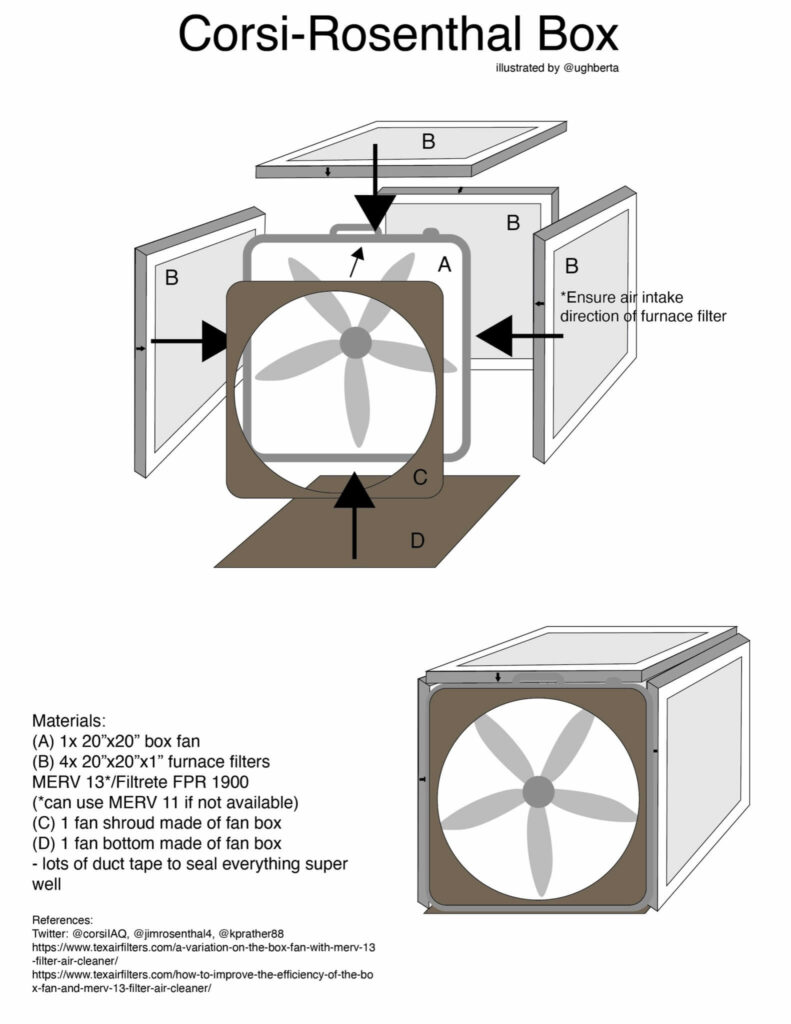
Here is the CR Box’s side-lying action. I recommend this setup, with the fan pointing away from your primary work area, to draw through the filters any pastel dust you create:
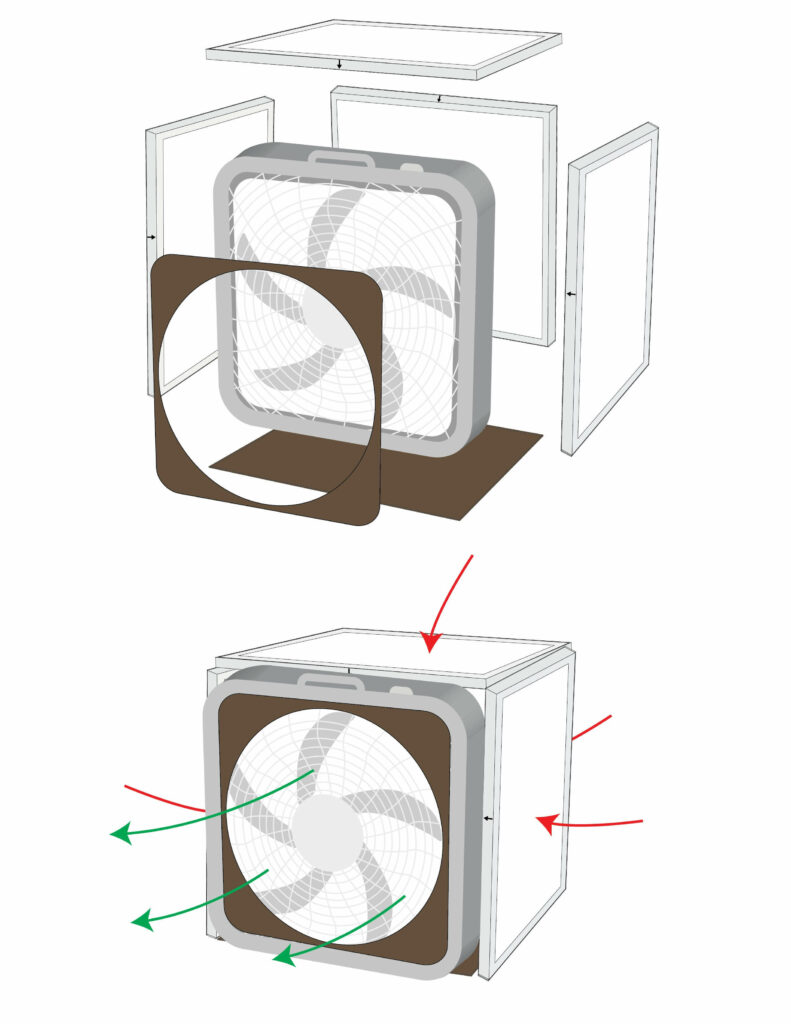
This top-pointing action is probably less useful for an art studio, as the fan may disturb any surfaces and supplies above it:
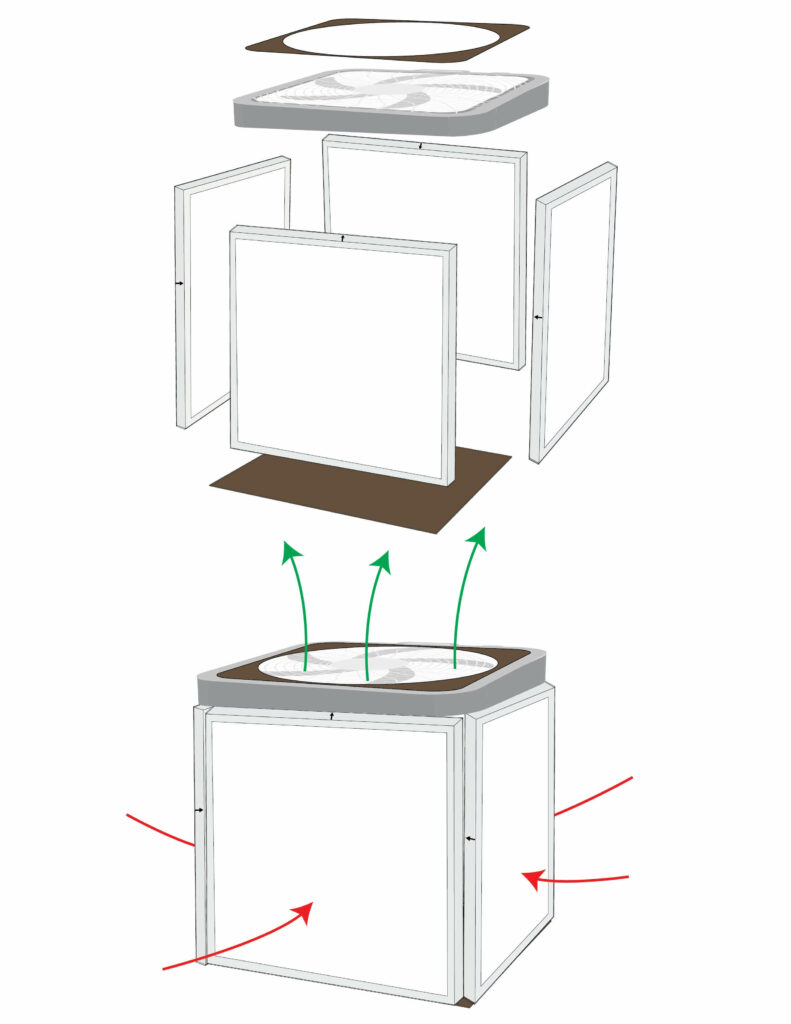
The Importance of Fan Shrouds
A fan shroud significantly increases air draw, and thus filtration, without taxing or compromising the fan’s motor (see bottom of article). As a result, the “shroud,” or partial fan-face covering in the illustrations above, is a must. In How to Improve the Efficiency of the Corsi-Rosenthal Box Air Cleaner, Rosenthal states, “The idea is to cover the corners without covering any of the fan itself.”
Further, here are two optimized fan shrouds for common fan models (at least in the U.S., I guess), showing that you can also simply use tape. Not as attractive, but it works:

Find more information on building CR Boxes here.
Footnotes
*
Some fixatives can darken a completed pastel painting. Test your fixative on a sample of the pastels and paper you’re using, to see its effects. Different pastels and papers react differently. Lascaux Fixative has a really great reputation for no (or minimal) color change, when used as directed. On the other hand, and as mentioned above, SpectraFix Degas Spray Fixative reportedly causes no color shifts.
Further, some pastel colors are fugitive, just like any other colored artist medium. A fugitive color means it can change appearance over time, when exposed to light, air, or for other reasons. This is why, in some old paintings, people’s skin looks bluish. Originally, the skin tones were painted to look natural, but the pigment slowly aged and changed color. Therefore, if using fugitive colors concerns you, check each stick of pastels for its color-fastness labeling. [back to text]
**
Years ago, I took at test where I had to put hundreds of colors in order, and received a 100% accuracy score. Perhaps this is one reason why I am so affected by sublime colors, and endeavor to communicate the beauty I see to anyone who views my work. [back to text]
I hope you have found this blog post to be informative, and helpful, in clearing up any confusion about working safely with pastels!
Thanks for your time and attention, both are valuable. 🙏🏻
I invite you to view my photographs and paintings, and to learn more about me.
If you liked this post, you have options:
- Check out the art available in my shop!
- Buy me a coffee (I’d be so grateful!), or check out my Patreon (coming soon!).
- Sign up for my monthly newsletter, full of delicious tidbits.
- Follow my blog with RSS, using a feed reader like Feedly.
- Browse my other blog posts.
©Marlene Breitenstein. I welcome your inquiries about purchasing, licensing, or republishing my work. I take my intellectual property seriously. This post and its contents, unless otherwise noted, is owned by Marlene Breitenstein. It is not to be reproduced, copied, or published in derivative, without permission from the artist.




